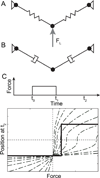Physics and the canalization of morphogenesis: a grand challenge in organismal biology
- PMID: 21750364
- PMCID: PMC3200556
- DOI: 10.1088/1478-3975/8/4/045002
Physics and the canalization of morphogenesis: a grand challenge in organismal biology
Abstract
Morphogenesis takes place against a background of organism-to-organism and environmental variation. Therefore, fundamental questions in the study of morphogenesis include: How are the mechanical processes of tissue movement and deformation affected by that variability, and in turn, how do the mechanic of the system modulate phenotypic variation? We highlight a few key factors, including environmental temperature, embryo size and environmental chemistry that might perturb the mechanics of morphogenesis in natural populations. Then we discuss several ways in which mechanics-including feedback from mechanical cues-might influence intra-specific variation in morphogenesis. To understand morphogenesis it will be necessary to consider whole-organism, environment and evolutionary scales because these larger scales present the challenges that developmental mechanisms have evolved to cope with. Studying the variation organisms express and the variation organisms experience will aid in deciphering the causes of birth defects.
Figures




References
-
- Acs N, Banhidy F, Puho E, Czeizel AE. Maternal influenza during pregnancy and risk of congenital abnormalities in offspring. Birth Defects Res A Clin Mol Teratol. 2005;73:989–996. - PubMed
-
- Adams DS, Keller R, Koehl MA. The mechanics of notochord elongation, straightening and stiffening in the embryo of Xenopus laevis. Development. 1990;110(1):115–130. - PubMed
-
- Alonso MI, Gato A, Moro JA, Barbosa E. Disruption of proteoglycans in neural tube fluid by beta-D-xyloside alters brain enlargement in chick embryos. Anatomical Record. 1998;252:499–508. - PubMed
-
- Bachmann K. Temperature Adaptations of Amphibian Embryos. The American Naturalist. 1969;103:115–130.
-
- Beloussov LV, Grabovsky VI. Morphomechanics: goals, basic experiments and models. Int J Dev Biol. 2006;50:81–92. - PubMed
Publication types
MeSH terms
Grants and funding
LinkOut - more resources
Full Text Sources
